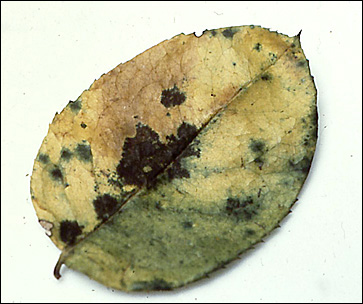Leaf Spots, plant diseases
 Leaf Spots are spots of dead or discoloured tissue on a leaf, often brown or black.
Leaf Spots are spots of dead or discoloured tissue on a leaf, often brown or black.
They are some of the most common diseases. Most leaf spots flourish after wet weather.
They rarely require attention, except at times when there is a serious outbreak.
Affected leaves should always be removed and sprayed though to prevent further infection.
A large range of different fungi and bacteria cause different leaf spots on different types of plants, including ones which cause other diseases (eg. Alternaria, Anthracnose and Septoria etc).
Bacterial Leaf Spot (Pseudomonas syringae)
On beans this disease is often called "brown spot". The leaves have small brownish spots of circular or irregular shape. It is frequently surrounded by a narrow lime coloured halo. The spot may fall out in time leaving holes. On pods, the damage is dark green water soaked spots with reddish brown margins.
Control: use disease-free seed, avoid susceptible cultivars, prevent traffic between infected crops and non-infected crops, and plough in crops immediately after harvest. A preventative spray of Mancozeb every 7 to 10 days may be helpful.
Bacterial Dry Leaf Spot (Xanthomonas vitians)
On lettuce, the leaves produce small angular water soaked spots which dry out and become papery. If infection is severe, large areas become yellow, brown then die.
Control: Do not use area which has previously been infected. Cool, showery weather favours infection.
Bacterial Spot in Pumpkins (Xanthomonas cucurbitae)
On leaf: small tannish-yellow spots scattered over the leaf. Severe spotting results in brown sections usually at the margins of the leaf.
On fruit: small water soaked areas with a light brown ooze. As the fruit matures, these ooze areas develop into enlarged dried yellow crusts over the spot. Flesh beneath the spot darkens and water soaks to the seed region.
Control: use disease-free seed, use treated seed, plough in crop immediately after harvesting.
Cercospora Leaf Spot (Cercospora beticola)
Symptoms are greyish spots with brown edges, occurring mostly in warm, humid conditions (e.g. 25-30 degrees C). It commonly occurs on silver beet, beetroot & related plants.
Control: Copper spray & good hygiene.
Anigiozanthus Ink Spot
Black spots sometimes becoming stripes develop on Kangaroo Paw leaves. A. flavidus and some resistant varieties (eg. Bush Gems hybrids) are the most resistant. This disease is less likely to occur in dry climates. Burning most of the foliage can destroy the disease and the plants will regrow.
Black Spot on Rose
Related to Anthracnose diseases (caused by the same pathogens).
Symptoms: Leaves develop small to large black, circular spots. On some varieties they are raised, reddish purple spots which become darker over time. Usually tissue around the spot becomes pale in colour. Badly affected leaves can become very yellow and drop.
Most likely to occur in warm, wet conditions.
Control: Hygiene - remove & burn affected leaves, prune off wood holding infected leaves, and burn. Spray benomyl, zineb, mancozeb or dust sulphur-copper (apply when detected, repeat every 10 days during growing seasons).
Want to Learn More?
Check out publications in the ACS Bookshop: www.acsbookshop.com
For more information on Courses on Pests & Diseases:
In Australia: www.acs.edu.au/Courses/General-Horticulture-courses.aspx
In the UK: www.acsedu.co.uk/Courses/General-Horticulture-Courses.aspx
You may also be interested in....
Exceptional training for a serious business or career -lots of different options to specialize.
View Course